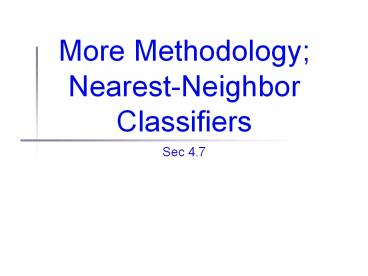More Methodology; Nearest-Neighbor Classifiers - PowerPoint PPT Presentation
1 / 24
Title:
More Methodology; Nearest-Neighbor Classifiers
Description:
Don't evaluate accuracy (performance) of your classifier (learning system) on ... What happens if one axis is measured in microns and one in lightyears? ... – PowerPoint PPT presentation
Number of Views:15
Avg rating:3.0/5.0
Title: More Methodology; Nearest-Neighbor Classifiers
1
More MethodologyNearest-Neighbor Classifiers
- Sec 4.7
2
Review Properties of DTs
- Axis orthagonal, hyperrectangular,
piecewise-constant models - Categorical labels
- Non-metric
3
Separation of train test
- Fundamental principle (1st amendment of ML)
- Dont evaluate accuracy (performance) of your
classifier (learning system) on the same data
used to train it!
4
Holdout data
- Usual to hold out a separate set of data for
testing not used to train classifier - A.k.a., test set, holdout set, evaluation set,
etc. - E.g.,
- is training set accuracy
- is test set (or
generalization) accuracy
5
Gotchas...
- What if youre unlucky when you split data into
train/test? - E.g., all train data are class A and all test are
class B? - No red things show up in training data
- Best answer stratification
- Try to make sure class (feature) ratios are same
in train/test sets (and same as original data) - Why does this work?
- Almost as good randomization
- Shuffle data randomly before split
- Why does this work?
6
More gotchas...
- What if your data set is small?
- Might not be able to get perfect stratification
- Cant get really representative accuracy from any
single train/test split - A cross-validation
- for (i0iltki)
- Xtrain,Ytrain,Xtest,Ytest
- splitData(X,Y,N/k,i)
- modelitrain(Xtrain,Ytrain)
- cvAccsimeasureAcc(modeli,Xtest,Ytest)
- avgAccmean(cvAccs)
- stdAccstddev(cvAccs)
7
(No Transcript)
8
But is it really learning?
- Now we know how well our models are performing
- But are they really learning?
- Maybe any classifier would do as well
- E.g., a default classifier (pick the most likely
class) or a random classifier - How can we tell if the model is learning
anything? - Go back to first definitions
- What does it mean to learn something?
9
The learning curve
- Train on successively larger fractions of data
- Watch how accuracy (performance) changes
10
Measuring variance
- Cross validation helps you get better estimate of
accuracy for small data - Randomization (shuffling the data) helps guard
against poor splits/ordering of the data - Learning curves help assess learning
rate/asymptotic accuracy - Still one big missing component variance
- Definition Variance of a classifier is the
fraction of error due to the specific data set
its trained on
11
Measuring variance
- Variance tells you how much you expect your
classifier/performance to change when you train
it on a new (but similar) data set - E.g., take 5 samplings of a data source
train/test 5 classifiers - Accuracies 74.2, 90.3, 58.1, 80.6, 90.3
- Mean accuracy 78.7
- Std dev of acc 13.4
- Variance is usually a function of both classifier
and data source - High variance classifiers are very susceptible to
small changes in data
12
Putting it all together
- Suppose you want to measure the expected accuracy
of your classifier, assess learning rate, and
measure variance all at the same time? - for (i0ilt10i) // variance reps
- shuffle data
- do 10-way CV partition of data
- for each train/test partition // xval
- for (pct0.1pct0.1pctlt0.9) // LC
- Subsample pct fraction of training set
- train on subsample, test on test set
- avg across all folds of CV partition
- generate learning curve for this partition
- get mean and std across all curves
13
Putting it all together
hepatitis data
14
5 minutes of math...
- Decision trees are non-metric
- Dont know anything about relations between
instances, except sets induced by feature splits - Often, we have well-defined distances between
points - Idea of distance encapsulated by a metric
15
5 minutes of math...
- Definition a metric function
- is a function that obeys the following
properties - Identity
- Symmetry
- Triangle inequality
16
5 minutes of math...
- Examples
- Euclidean distance
Note omitting the square root still yields a
metric and usually wont change our results
17
5 minutes of math...
- Examples
- Manhattan (taxicab) distance
- Distance travelled along a grid between two
points - No diagonals allowed
18
5 minutes of math...
- Examples
- What if some attribute is categorical?
19
5 minutes of math...
- Examples
- What if some attribute is categorical?
- Typical answer is 0/1 distance
- For each attribute, add 1 if the instances differ
in that attribute, else 0
20
Distances in classification
- Nearest neighbor find the nearest instance to
the query point in feature space, return the
class of that instance - Simplest possible distance-based classifier
- With more notation
21
(No Transcript)
22
(No Transcript)
23
(No Transcript)
24
NN miscellaney
- Slight generalization k-Nearest neighbors (k-NN)
- Find k training instances closest to query point
- Vote among them for label
- Q How does this affect system?
- Gotcha unscaled dimensions
- What happens if one axis is measured in microns
and one in lightyears? - Usual trick is to scale each axis to -1,1 range































